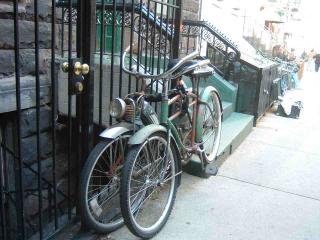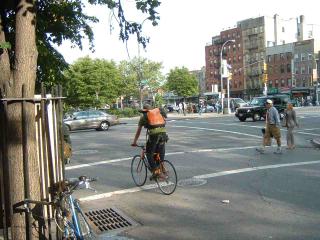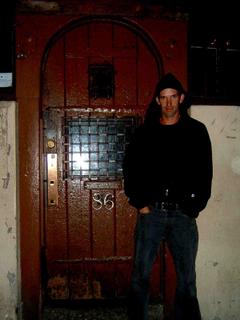New York City, Bohemia and the Corner of 1st and 1st

In a spontaneous fit of island claustrophobia we sprint for the 7:15 am downtown ferry to catch the 9:50 flight for Puerto Rico for the 11:21, etc. etc... all the way to the sleepless soul of America - New York City. Many hours later we find ourselves standing between canyon walls of steel and glass on a brisk spring afternoon.
I'm searching for something. A small splinter from my shattered family tree. I have roots in the cracks of New York's broken sidewalks. My mother watched Robert Zimmerman write songs at the Gaslight Cafe, before he became Bob Dylan. My father attended "The New School" and my grandfather, Loker Raley, was a respected poet during the bohemian revival of the 1950's. He also witnessed it's decline into hippiedom and wrote about it in a book entitled, Bye Bye Bohemia. He lived and worked in Greenwich Village and ultimately we plan to retrace his steps and rediscover my family dynasty, even if its just an espresso and a dust jacket on the wall of a pub.

Hiding from the manicured sidewalks and the neat grid of midtown we find a hole in the ground and take a subway downtown. The smells are pungent, like cotton candy, sweat and train brake linings. A few pickpockets still lurk the subterranean hallways of New York's subway trains. An announcement comes over the speaker, "please watch your valuables." We all pause - the sitters facing the standers - and wonder, who is the pickpocket among us? There's a great racket of couplings, made all the more ominous by the dark tunnels, and we tumble downtown and underground. The train roars out of the dark into a white tiled station.
The subway has taken us to the East Village which mirrors Greenwich Village like an alter ego, a haunting ghost of what Greenwich used to be, or might have been, if yuppies hadn't been introduced like an exotic weed. Greenwich has the mighty Hudson, the East Village has, well, the East River.

Alphabet city, avenue A, B and C used to be where bad people hung out and did bad things. Now there are sidewalk cafe's and restaurants. Random art displays itself in the streets or on the sides of buildings. Nineteen fifty's kitsch perseveres, like "Paul's Palace" with the french fries guy outside, a six foot sculpted cup of fries with eyes, complete with shoes and completely ignorant that "french" fries has become a bad word in America.
We beat the street, looking for the odd and unusual. I get the feeling we're only touching the surface. That beneath the storefronts and cafes there lurks an underground even more creative and off beat. An entire culture, counter - sub - whatever, that exists out of the bounds of the Starbucks studded strip malls. The tarmac has to end somewhere, and this little corner of the world seems to be the pot at the end of the rainbow, except the rainbow celebrates diversity and the pot is, probably, just pot.
The East Village is a wonderful celebration of what moderate rents can do for a place. Artists need refuge from the constant suck of money. Greenwich Village used to be that place. An incubator for hatching talent. People clambered around in abandoned factory studios, writing, painting, playing. It's where Andy Warhol traded Bob Dylan a painting for a couch. My grandfather formed an impromptu playhouse in an abandoned warehouse. There was poetry and jazz and everyone in the park playing bongos and digging the scene. Greenwich was the low rent district of the lower west side - the meat packing district - and artists could create uninterrupted. But New York is still breathing, you just have to look in the cracks. The East Village is a kind of crack in the facade of American normalcy.

The sign says, "Strong Coffee sold here." The corner of first and first, "the nexus of the universe" our barrista tells us from inside her little hut. Outside chairs and tables crowd the sidewalk and across the sleepy street, bicycles line the park fence. It's a kind of oasis in the prison of concrete and steel and is all the sweeter because of it's oddity.
But the New York of my childhood was a little wilder, there were more characters, people always approaching, hustling, friendly but unpredictable. The city of my youth was dirty, and dangerous. Times Square was illuminated by the neon smut of porn. Shady characters whispered into your ear, offering a menu of illegal opportunities from fake ID's to drugs. Lower West Side hookers needled the abandoned alleyways of the meat packing district with their stiletto heels. And everywhere, except for the very Upper West Side, there was the threat of being mugged. What happened to all the crazy people? The city seems a little more tame, a little less alive, less threatening.

We plot our next move, to Greenwich Village - crosstown. Our directions are pretty simple, pick a street and head west. We are focused on our mission, to find the elusive Chumley's and rediscover a piece of lost bohemia. To stand in the same place my grandfather did and try to imagine. I have a picture. In it my grandfather is standing in the middle of a crowded pub, dressed in a suit and reading rather dramatically from the poem in his outstretched arm. Behind him an old style juke box sits in the corner. He is surrounded on all sides by people, some listening, some doing other things. He looks lost in his poem and indifferent to it's reception.
We walk a few blocks in the frigid fifty degree air while New Yorkers sport shorts and T shirts, for them it's spring. We hop a cab for the sheer adventure and warmth. We get off on the corner of Bleeker and Grove. Immediately things are different. Small four story brownstone

walkups line the treed streets. Tarmac gives way to old rounded cobblestones. I can almost hear the echoing of horse hoofs on the polished stones. We are "off the grid" because over here, on the Lower West Side, streets meander with no attention to the four points of a compass or the constraints of the streets and avenues that divide the rest of Manhattan. It is quiet, somehow beyond the incessant noise of the rest of the city. We are immediately lost. Standing on the corner of 7th avenue, Bleeker St and Barrow St. we wonder if perhaps this isn't the nexus of the universe.
In the 1950's my grandfather was somewhat of a Greenwich Village regular, teaching at Columbia, he spent his free time publishing a small bohemian magazine, hosting a radio show, writing poetry, reading poetry in Village hangouts and writing a few books. We are in search of one of those books right now, or at least it's dust
 cover, which is reportedly on the wall at the
cover, which is reportedly on the wall at thephantom pub known only as Chumley's. A place so hard to find this is my third attempt.
We are wandering down a dark, quiet street and it suddenly dead ends. We spin on our heals and head the other way. I've lost all sense of direction, operating on some kind of familial instinct. I am tracking the ghost of grandfather beat through the back streets of 1954 Greenwich Village. We disturb a New Yorker just entering her brownstone, she impatiently tells us to, "go up a block and turn left." Finally, across the dark street, we see a thick arched wood door. A steel grate covers the small window which spills a narrow column of light onto the cobblestones. There is no sign. We open the door to a dark entry way, up a few steps and we are standing above a packed english pub. Noise, heat, the smell of stale beer and hot pub fries and everywhere there are pictures and dust jackets. The walls are papered in them. We search for the title. If it is here, grandfather is among good company, Allan Ginsberg's scandalous Howl, F. Scott Fitzgerald's The Great Gatsby, William Burrough's Naked Lunch, Salinger's Franny and Zooey and many, many other writers. Chumley's has been a kind of refuge for the underground literati since the 1930's.
I ask a stocky guy who works there if there is any order to the things on the walls. He tells me in a thick, decidedly non - literati accent, that the fireman are in back and the rest are writers.

He gestures towards the back where there are framed pictures of the hook and ladder boys lost during the awful collapse of the twin towers. Suddenly there is a knocking, not at the door but at our feet. The man I'm talking to reaches down and pulls up the floor allowing a bar back, laden with beer, to climb up from beneath us. I see why my grandfather must've like this place. It's a cold slice of legitimacy in a theme park world.
It's awkward to search for the book jacket because I have to stand in front of people's tables to peruse the jackets behind them. I try to match the picture of my grandfather to this place but it's tough to say. I give up and go outside to call my parents.
"Ok I found Chumleys but there are hundreds of book jackets and hundreds of people."
"It's called Ode to the Newborn, my dad explains, "we think it's about your mother."
I go back inside and suddenly I see it. It's entitled Salute to the Newborn. It is written in a kind of calligraphy with mysterious lines above the "A's including the one in grandfather's name, Loker Raley. The jacket has a sketch of a naked man, his head is mysteriously cut off, he is holding something which is also above the top of the jacket. It is a humble, plain dust cover, but there it is, up on the wall shoulder to shoulder with some of the greatest authors of the 20th century.

Back at the jetblue terminal at Kennedy airport we sit under dusty plastic palm trees and ready ourselves to return home. St John awaits, starkly contrasted against the urban wonderland of New York City. Retracing my grandfather's steps gave me a renewed sense of identity as well as a glimpse of the back street vibe of 1950's New York. I return with a rekindled passion for literature and island life. Thank you grandfather beat.

4 Comments:
Have not had the time to entirely read this posting, but are you Darcy or Lanier? And are you in touch with Dell? PF
Should have added to 4:35 PM, April 3, 2006 note: wildplum@epix.net
Sorry, this is being perused piecemeal and I was assuming you were your father or your uncle (and the reference was, of course, to you aunt). Can you provide any information regarding Loker's children---It has been a long time since I visited him in those final days and nights in Woodstock, and even longer since we spent thousands of days in that communitiy which long ago perished, especially in the Square, Minetta's, San Remo's, Salle de Champagne, and innumerable other locations, apart, of course, from each others "digs," except those times when they were one. pf
I new your grandfather very well. He past away from a heart attack cradled in my best friends arms in the stairwell of the apartment building he lived in just off of the village green in Woodstock. My dad was a radio announcer and made several recordings of him. One of which I still have from the1950’s. Is Darcy your dad, or is your mom Dell?
Lanier and I were childhood friends. He helped me with my paper route, and we spent many days hanging out together. It would be fun to here back from you, or any one else that may be interested. E-mail me if you care to at emap@qwest.net .
Post a Comment
<< Home